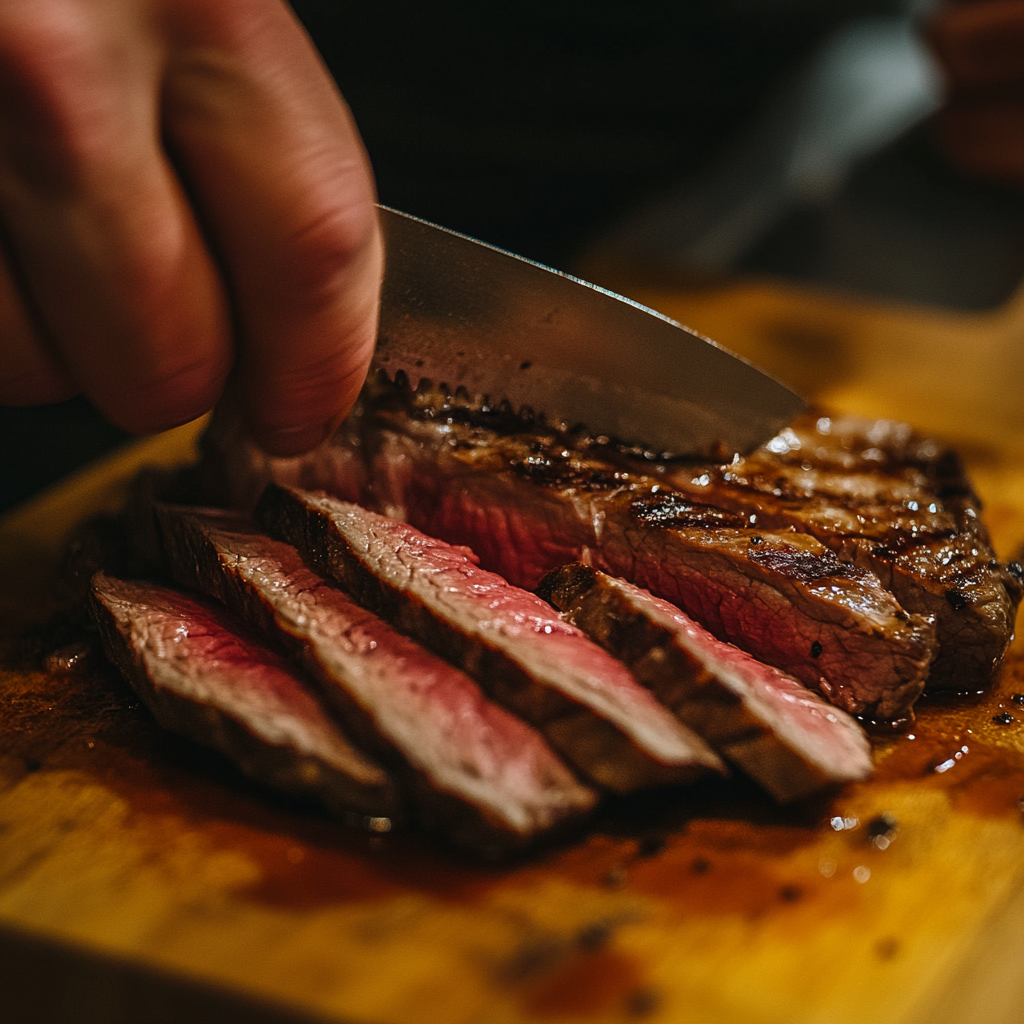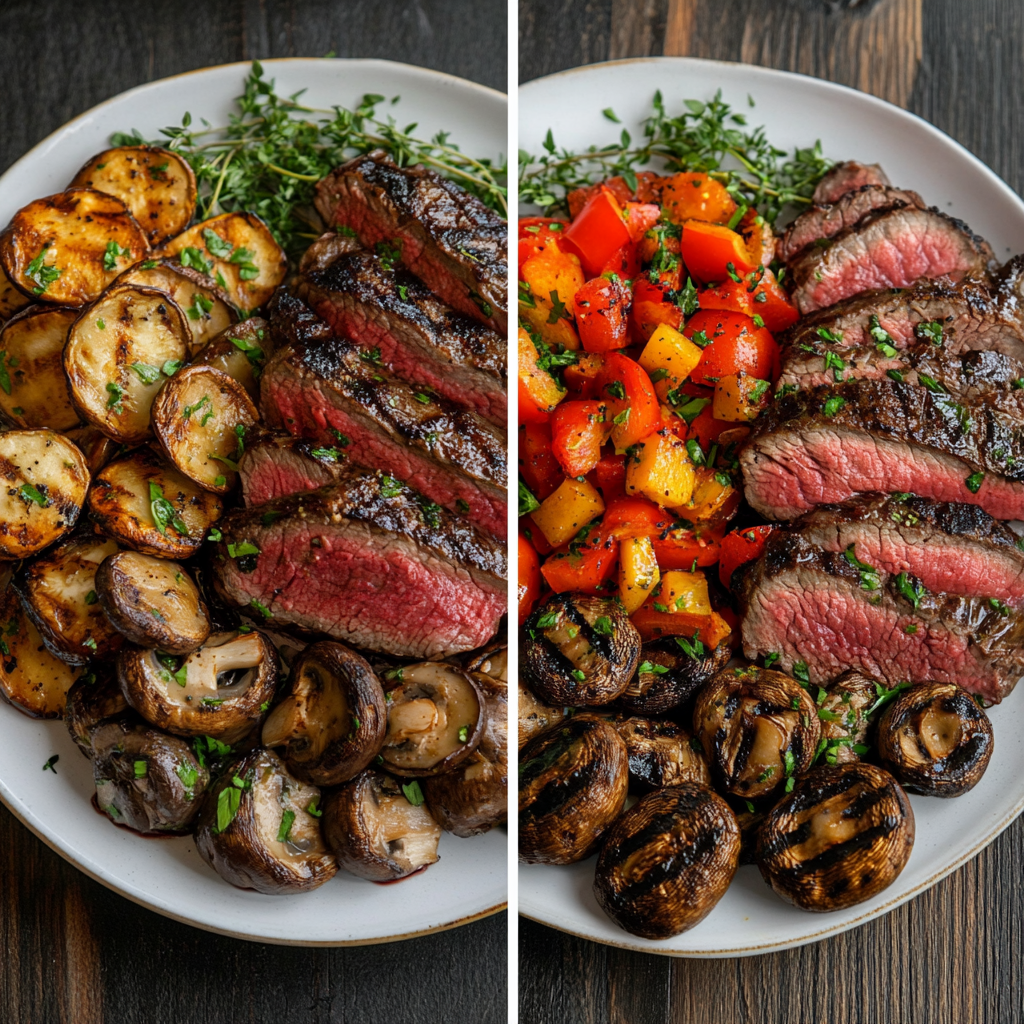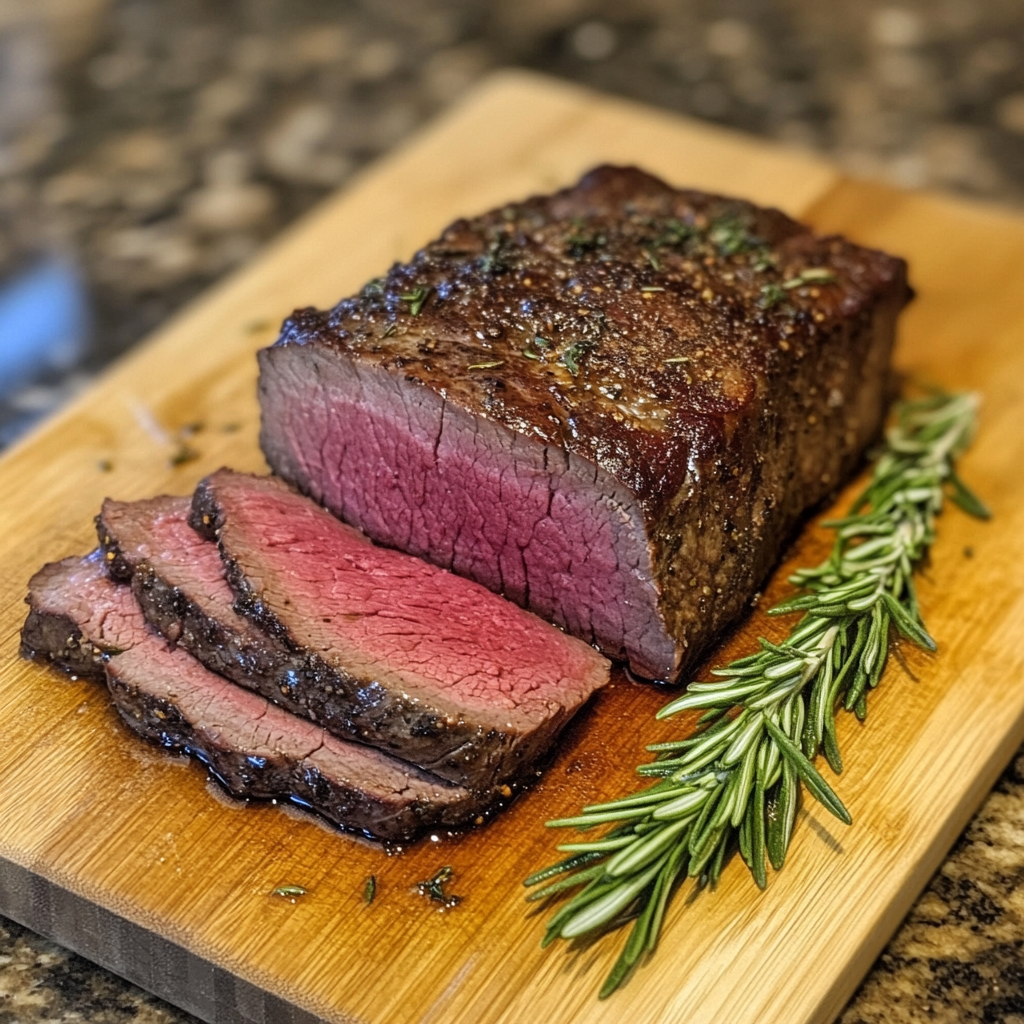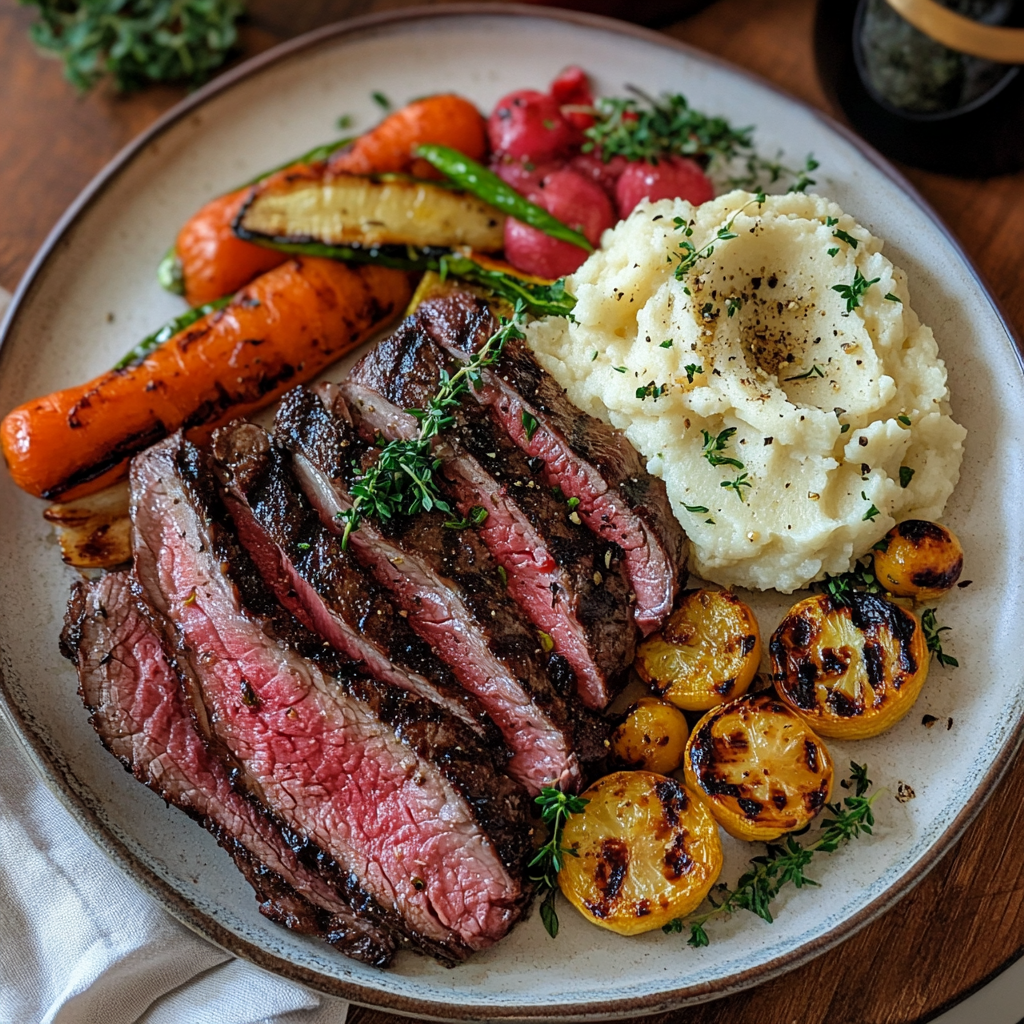Diabetic-Friendly London Broil Recipe
Eating healthily doesn’t mean compromising on flavor, and that’s especially true for those managing diabetes. With careful attention to ingredients and preparation, you can create mouth-watering meals that both satisfy your cravings and help maintain stable blood sugar levels. One such meal is this diabetic-friendly marinated London broil recipe, a dish that packs bold flavors while keeping carbohydrates low and protein high.
Not only is this recipe diabetic-friendly, but it’s also versatile enough for anyone looking to eat more healthily without sacrificing taste. Whether you’re cooking for yourself, your family, or hosting guests, this London broil recipe can fit into almost any meal plan or dietary preference. The secret to its deliciousness is in the marinade—a zesty, flavorful blend of ingredients designed to tenderize the meat and create layers of flavor with every bite.
This article will take you step-by-step through the process of creating this amazing dish, from choosing the right ingredients to perfecting the cooking method. Along the way, you’ll also learn about ways to customize the recipe for various dietary needs, how to pair it with complementary sides, and how to store any leftovers. So, whether you’re cooking for lunch, dinner, or a special occasion, this recipe is a go-to option that delivers flavor and health benefits in every serving.
For more healthy dinner options, be sure to check out our collection of diabetic-friendly and low-carb recipes in the Dinner category Explore More Healthy Dinner Recipes Here. Let’s dive in and discover how easy it is to prepare this nutritious and delicious London broil.
Ingredients Overview: Wholesome, Flavorful, and Perfect for Diabetic Diets
The key to a great dish lies in the quality and balance of its ingredients. This diabetic-friendly marinated London broil recipe utilizes fresh, nutritious ingredients that not only provide flavor but also contribute to your overall health. For individuals managing diabetes, it’s crucial to select foods that support stable blood sugar levels, offer healthy fats, and are packed with protein. This recipe delivers on all fronts, ensuring that every bite is not only delicious but also nutritious.
Here’s a breakdown of the primary ingredients in this dish, along with potential substitutions for those with specific dietary needs or preferences:
Main Ingredients:
- London Broil (Top Round or Flank Steak): London broil is traditionally made from either the top round or flank steak, both of which are lean cuts of beef. These cuts are perfect for this recipe because they are high in protein and low in fat, making them suitable for individuals looking to manage their blood sugar without sacrificing a hearty, satisfying meal. These cuts also benefit from marinades, as the acidity helps break down the muscle fibers, resulting in a tender, flavorful dish.
- Olive Oil: Olive oil serves two purposes in this recipe. First, it acts as the base of the marinade, helping to coat the steak and infuse it with flavor. Second, it provides healthy fats that are essential for a balanced diet, particularly for those with diabetes. Rich in monounsaturated fats, olive oil is known to support heart health and reduce inflammation, making it a key ingredient for this recipe.
- Garlic: Adding garlic not only enhances the overall flavor of the dish but also brings a host of health benefits. Garlic contains antioxidants and has anti-inflammatory properties, both of which are important for individuals managing chronic conditions like diabetes. It also has a natural sweetness that deepens when cooked, complementing the rich flavors of the steak.
- Low-Sodium Soy Sauce: Soy sauce adds an umami flavor to the marinade, which enhances the taste of the beef. By opting for a low-sodium variety, you can keep the dish heart-healthy and reduce your overall salt intake. This is especially important for people with diabetes, who may also need to monitor their sodium levels to support heart health and reduce the risk of hypertension.
- Lemon Juice: Lemon juice adds a bright, acidic note to the marinade, which helps tenderize the meat and balance the savory flavors. It also provides a burst of vitamin C, which supports immune function and overall health. The acidity from the lemon helps break down the tough muscle fibers in the steak, making it more tender and flavorful when cooked.
- Balsamic Vinegar: While some marinades use sugar or honey to add sweetness, this diabetic-friendly marinade uses balsamic vinegar, which brings a mild, natural sweetness without the need for added sugars. Balsamic vinegar also contains antioxidants and can help stabilize blood sugar, making it a perfect ingredient for this recipe.
- Fresh Herbs and Spices (Thyme, Oregano, Black Pepper): Herbs and spices play a critical role in this dish by adding depth and complexity to the flavor profile. Thyme and oregano offer a fresh, earthy aroma, while black pepper provides a subtle heat that complements the other ingredients. Herbs and spices are an excellent way to enhance flavor without adding extra calories, carbs, or sodium.
Ingredient Substitutions:
While the main ingredients of this recipe are perfect for creating a balanced, flavorful meal, there are a few substitutions you can make to accommodate different dietary preferences:
- Gluten-Free: For those who are sensitive to gluten, simply swap out the soy sauce for a gluten-free alternative like tamari or coconut aminos. Both options provide a similar umami flavor without the gluten.
- Vegan or Vegetarian Option: If you’re looking to make a vegetarian or vegan version of this dish, consider using portobello mushrooms as a substitute for the steak. The large, meaty caps of portobello mushrooms hold up well to marinades and grilling, making them an excellent plant-based alternative to beef.
- Low-Carb and Keto-Friendly: For those following a strict low-carb or keto diet, replace the balsamic vinegar with apple cider vinegar. This vinegar has even fewer carbohydrates and maintains the acidity needed for the marinade. You can also swap the soy sauce for coconut aminos to further reduce carb content.
If you’re interested in more healthy substitutions or diabetic-friendly snack ideas, visit our Snacks section Explore Healthy Snack Options Here, where you can find recipes and tips for staying on track with your dietary goals.

Tools Needed: Essential Equipment for Cooking London Broil
Creating the perfect marinated London broil doesn’t require fancy equipment, but having the right tools on hand can make the process smoother and more efficient. If you’re just getting started with cooking or don’t have a fully stocked kitchen, don’t worry—many of these tools can be easily substituted or adapted. Below is a list of essential tools for preparing this dish, along with suggestions for alternatives if needed.
Essential Kitchen Tools:
- Grill or Cast-Iron Skillet: A grill is ideal for achieving that smoky, charred flavor that London broil is known for. However, if you don’t have access to a grill, a cast-iron skillet works just as well for getting a good sear and locking in the juices. The high heat of cast iron helps create a beautiful crust on the steak, which adds both flavor and texture.
- Mixing Bowl: You’ll need a mixing bowl to combine the ingredients for the marinade. A medium-sized bowl should be sufficient for whisking together the olive oil, soy sauce, balsamic vinegar, and other ingredients.
- Meat Thermometer: A meat thermometer is key to ensuring that your London broil is cooked to your desired level of doneness. For medium-rare, the internal temperature should be between 130°F and 135°F. A thermometer takes the guesswork out of cooking and helps prevent overcooking, which can make lean cuts like top round or flank steak tough and dry.
- Sharp Knife: When it comes to slicing your London broil, a sharp knife is essential. A dull knife will tear the meat, whereas a sharp knife will allow you to make clean, thin slices. The thinner the slices, the more tender the meat will feel, which is especially important when working with lean cuts.
- Tongs: Using tongs to flip the steak ensures that you maintain control over the cooking process without piercing the meat. Piercing the steak with a fork or knife can cause the juices to escape, resulting in a drier, less flavorful steak.
Tool Alternatives:
- No Grill or Cast-Iron Skillet? If you don’t have a grill or cast-iron skillet, you can use a regular frying pan or even your oven’s broiler. The broiler provides high, direct heat, similar to a grill, and can help you achieve a similar charred exterior on the steak.
- No Meat Thermometer? If you don’t have a thermometer, you can check the doneness of the steak by feel. Press the steak gently with your finger or a spatula. A rare steak will feel soft and spongy, while a medium steak will feel slightly firmer. A well-done steak will feel very firm and springy.
If you’re looking for more dinner recipes that require minimal tools and equipment, visit our Dinner section Browse Easy-to-Make Dinner Recipes Here for inspiration.
Step-by-Step Instructions: Making the Perfect Marinated London Broil
Preparing the perfect diabetic-friendly marinated London broil is simpler than you might think. With just a few key steps, you’ll be on your way to a delicious, flavorful meal that’s both satisfying and healthy. Even if you’re new to cooking, these step-by-step instructions will guide you through the entire process, ensuring that your dish turns out perfectly every time.
Step 1: Prepare the Marinade
Start by preparing the marinade. In a medium mixing bowl, whisk together the olive oil, garlic, lemon juice, balsamic vinegar, soy sauce, thyme, oregano, and black pepper. Be sure to whisk thoroughly until the ingredients are well combined and emulsified. The marinade should be smooth, with the oil fully incorporated into the vinegar and other ingredients. This ensures that each bite of steak will be infused with flavor.
Step 2: Marinate the Steak
Place the London broil (top round or flank steak) into a large resealable plastic bag or a shallow dish. Pour the marinade over the steak, making sure it’s fully coated on both sides. Seal the bag or cover the dish with plastic wrap and place it in the refrigerator. For the best results, let the steak marinate for at least 4 hours, although overnight is ideal. The longer the steak marinates, the more the flavors will penetrate the meat, resulting in a tender, flavorful steak.
Marinating is crucial for this recipe because it helps to tenderize the lean cut of beef. The acidity from the lemon juice and balsamic vinegar breaks down the muscle fibers, making the steak more tender and easier to slice.
Step 3: Preheat Your Grill or Skillet
When you’re ready to cook the steak, preheat your grill or cast-iron skillet over medium-high heat. If you’re using a grill, make sure the grates are clean and well-oiled to prevent the steak from sticking. If you’re using a cast-iron skillet, add a small amount of olive oil to the pan and heat it until it’s shimmering but not smoking. The goal is to get the skillet hot enough to sear the steak quickly, locking in the juices.
Step 4: Sear the Steak
Remove the steak from the marinade and let any excess drip off. You don’t want too much marinade on the surface of the steak, as it can burn during cooking. Place the steak on the grill or in the skillet and sear it for 4-5 minutes on each side, depending on the thickness of the steak. You’re looking for a deep, caramelized crust to form on the surface of the steak, which adds both flavor and texture.
Step 5: Check for Doneness
Using a meat thermometer, check the internal temperature of the steak. For medium-rare, the internal temperature should read between 130°F and 135°F. If you prefer your steak cooked to medium, aim for a temperature of 140°F to 145°F. Once the steak reaches your desired doneness, remove it from the grill or skillet.
Step 6: Let the Steak Rest
Allow the steak to rest for about 10 minutes before slicing. This step is critical because it allows the juices to redistribute throughout the meat, ensuring that each slice is juicy and flavorful. If you slice the steak too soon, the juices will run out, leaving the meat dry and tough.
Step 7: Slice the Steak
Using a sharp knife, slice the steak thinly against the grain. Slicing against the grain is important because it shortens the muscle fibers, making the steak more tender and easier to chew. Arrange the slices on a platter and serve with your favorite side dishes.
For more step-by-step instructions and cooking techniques, check out our Dinner section Explore More Easy-to-Follow Dinner Recipes Here.

Flavor Variations: Customize Your London Broil for Any Taste
One of the great things about this marinated London broil recipe is its versatility. While the classic version is delicious on its own, there are many ways to customize the dish to suit different flavor preferences or dietary needs. Below are several variations that add unique twists to the recipe, ensuring that it can be tailored to your tastes.
Vegan or Vegetarian Option:
- Portobello Mushroom London Broil: For a vegetarian or vegan take on this dish, substitute the beef with large portobello mushrooms. The meaty texture of portobello mushrooms makes them an excellent stand-in for steak. Marinate the mushroom caps using the same marinade recipe, and grill them until tender and slightly charred. The mushrooms will absorb the marinade beautifully, giving them a rich, savory flavor.
Keto or Low-Carb Version:
- Keto-Friendly Marinade: To make this recipe even more keto-friendly, replace the balsamic vinegar with apple cider vinegar or red wine vinegar. Both vinegars are low in carbohydrates and add a tangy flavor that complements the steak. Additionally, you can substitute the soy sauce with coconut aminos, which has a similar umami flavor but contains fewer carbs.
Spicy Variation:
- Add Some Heat: If you enjoy a bit of spice, add a pinch of red pepper flakes or cayenne pepper to the marinade. The heat from the pepper will balance the richness of the steak and add a new layer of complexity to the dish. You can also serve the steak with a spicy dipping sauce, such as a Sriracha mayo or chipotle aioli, for an extra kick.
Looking for more ways to customize your meals? Check out our Dinner section Explore More Flavorful Variations Here to discover additional flavor combinations and cooking techniques.

Expert Tips: How to Perfect Your London Broil Every Time
Even the simplest recipes can be elevated with a few expert tips and techniques. Whether you’re a seasoned cook or a beginner, these tips will help you achieve the best possible results with your marinated London broil. From marinating to slicing, these suggestions will ensure that your steak turns out perfectly every time.
Marinating Tips:
- Marinate Overnight: For the best flavor, let the steak marinate overnight. While a minimum of 4 hours is sufficient, allowing the steak to soak in the marinade for 12-24 hours will intensify the flavors and further tenderize the meat. The longer the steak marinates, the more deeply the flavors will penetrate.
- Pat the Steak Dry: Before placing the steak on the grill or in the skillet, pat it dry with paper towels. Removing excess moisture ensures that the steak will develop a crisp, golden-brown crust. If the steak is too wet when it hits the grill or pan, it may steam rather than sear, resulting in a less flavorful crust.
Cooking Tips:
- Don’t Overcook the Steak: London broil is best served medium-rare to medium. Overcooking this lean cut of meat can make it tough and chewy, so it’s important to keep an eye on the internal temperature. A meat thermometer is the best tool for ensuring that the steak is cooked to your liking without overdoing it.
- Let the Steak Rest: After cooking, let the steak rest for about 10 minutes before slicing. This allows the juices to redistribute throughout the meat, ensuring that each bite is juicy and tender. If you slice the steak immediately after cooking, the juices will escape, leaving the meat dry.
- Slice Against the Grain: Always slice the steak against the grain. This shortens the muscle fibers and makes the meat easier to chew. Slicing with the grain, on the other hand, will result in tougher, chewier bites.
For more expert cooking tips and techniques, visit our Dinner section Master Your Cooking Skills Here.

Nutritional Information: Healthy, Balanced, and Delicious
This diabetic-friendly marinated London broil isn’t just delicious—it’s also packed with nutrients that make it an excellent choice for individuals managing diabetes or anyone looking to eat healthily. Below is a breakdown of the nutritional content of this dish, along with some of the health benefits associated with its ingredients.
Nutritional Breakdown:
- Calories: Approximately 250 calories per serving
- Protein: 30g per serving
- Carbohydrates: 5g per serving
- Fat: 12g per serving (primarily from heart-healthy olive oil)
Health Benefits:
- High in Protein: The London broil provides a significant amount of lean protein, which is essential for muscle repair and maintenance. Protein also helps stabilize blood sugar levels by slowing down the digestion and absorption of carbohydrates.
- Low in Carbohydrates: With only 5 grams of carbohydrates per serving, this dish is ideal for those managing their carbohydrate intake, including individuals with diabetes. The low-carb content helps prevent blood sugar spikes while still delivering a satisfying, hearty meal.
- Rich in Healthy Fats: The olive oil used in the marinade is a great source of monounsaturated fats, which are known to support heart health and reduce inflammation. For individuals managing diabetes, incorporating healthy fats into the diet is important for maintaining balanced blood sugar levels and overall well-being.
For more information on healthy meal planning and other nutritious recipes, explore our Dinner section Discover Nutrient-Rich Recipes Here.
Serving Suggestions: Pairing Your London Broil for a Complete Meal
To elevate your marinated London broil into a complete meal, consider pairing it with a variety of side dishes and beverages that complement its flavors. Whether you’re hosting a dinner party or enjoying a quiet meal at home, these serving suggestions will help you create a well-rounded, delicious dining experience.
Side Dishes:
- Grilled Vegetables: Bell peppers, zucchini, asparagus, and mushrooms are all excellent low-carb sides that can be grilled alongside the steak. The smoky, charred flavors of the vegetables complement the richness of the steak and add a burst of color and freshness to the plate.
- Cauliflower Mash: For a creamy, low-carb alternative to mashed potatoes, try making cauliflower mash. It’s rich, satisfying, and pairs beautifully with the marinated steak, providing a velvety texture that contrasts with the meaty slices of London broil.
- Green Salad with Lemon Vinaigrette: A crisp, refreshing salad made with mixed greens, cucumbers, and cherry tomatoes is a great way to balance the richness of the meat. A simple lemon vinaigrette adds brightness and acidity, enhancing the flavors of the steak without overpowering them.
Beverage Pairing:
- Red Wine: A glass of dry red wine, such as Cabernet Sauvignon, Merlot, or Pinot Noir, pairs beautifully with London broil. The tannins in the wine complement the robust flavors of the steak, while the acidity helps cut through the richness. Just be mindful of portion sizes, as wine contains carbohydrates that can impact blood sugar.
For more side dish inspiration and pairing ideas, explore our Dinner section Find the Perfect Sides for Your Meal.

Storage Tips: Keeping Leftovers Fresh and Delicious
If you find yourself with leftovers, there’s no need to worry. This marinated London broil stores beautifully and can be enjoyed for several days after it’s been cooked. Proper storage is key to maintaining the flavor and texture of the steak, and following these tips will ensure that your leftovers are just as delicious as the first serving.
Refrigerating Leftovers:
- Airtight Containers: After the steak has cooled completely, store the leftover slices in an airtight container in the refrigerator. Properly stored, the steak will stay fresh for up to 3 days. Be sure to layer the slices in a single layer or separate them with parchment paper to prevent them from sticking together.
Freezing Leftovers:
- Wrap and Freeze: If you want to save the leftovers for a later date, wrap the sliced steak tightly in plastic wrap or aluminum foil, and then place it in a freezer-safe bag or container. Label the container with the date, and freeze the steak for up to 3 months. When you’re ready to eat it, thaw the steak in the refrigerator overnight before reheating.
Reheating Tips:
- Reheat Gently: To avoid drying out the steak, reheat it slowly over low heat in a skillet. You can also reheat it in the oven at a low temperature (about 250°F) until it’s warmed through. Avoid using the microwave, as this can make the steak tough and chewy.
For more tips on storing and reheating leftovers, visit our Dinner section Find More Storage Tips Here.
FAQs: Common Questions About Cooking London Broil
Can I Make This Recipe Ahead of Time?
Absolutely! One of the great things about this marinated London broil recipe is that it can be prepared ahead of time. You can marinate the steak up to 24 hours in advance, which will enhance the flavor and tenderness. When you’re ready to cook, simply grill or sear the steak, and you’ll have a quick and delicious meal on the table in no time.
What Cut of Beef Should I Use for London Broil?
While London broil is traditionally made with top round or flank steak, you can also use other lean cuts of beef, such as sirloin or skirt steak. Just be sure to adjust the cooking time based on the thickness of the meat. Thicker cuts may require a bit more time on the grill or in the skillet, while thinner cuts will cook more quickly.
Conclusion: A Versatile and Diabetic-Friendly Recipe for Every Occasion
The diabetic-friendly marinated London broil recipe is a fantastic option for anyone looking to enjoy a healthy, flavorful, and satisfying meal. Its combination of lean protein, healthy fats, and bold flavors makes it a great choice for those managing diabetes, as well as for anyone who wants to eat a nutritious meal without sacrificing taste.
With its easy-to-follow preparation, customizable flavors, and compatibility with a variety of side dishes, this London broil is perfect for weeknight dinners, weekend gatherings, or special occasions. Whether you’re new to cooking or an experienced home chef, this recipe offers a delicious and nutritious way to enjoy a classic steak dinner.
For more healthy and delicious recipes, be sure to visit our Dinner section Explore More Healthy Dinner Recipes Here, and start creating meals that both you and your loved ones will enjoy.
You can also check out this insightful article on the benefits of incorporating lean proteins into your diet and how it can help manage blood sugar levels, especially for those managing diabetes. Read more about it on this blog: Lean Proteins and Diabetes Management.
